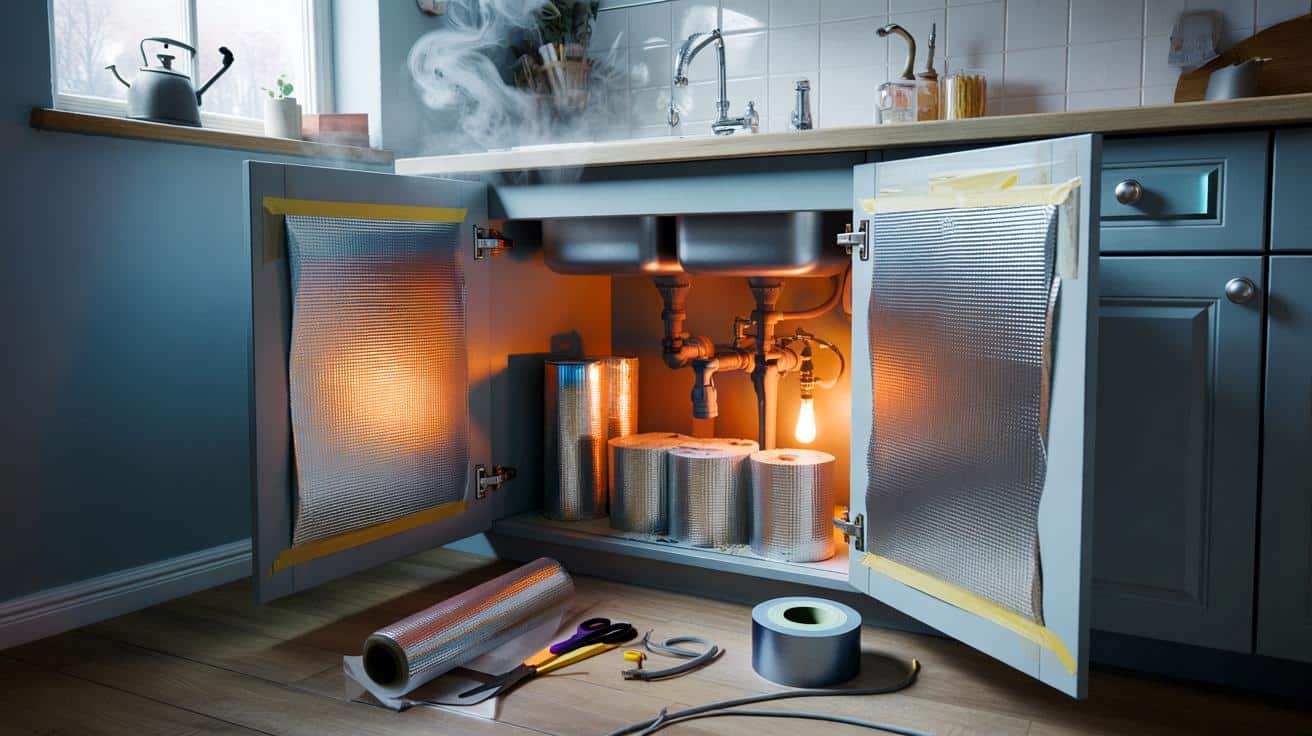I’m standing in a small London kitchen watching steam ribbon from the kettle while the under‑sink cupboard breathes out air like the inside of a fridge. The copper pipes are bare as bones, pushing heat straight into an external wall, and the washing-up water goes lukewarm before you’ve even found the scrubber. We’ve all had that moment when a winter snap makes the simplest chore feel like camping indoors.
Then a neighbour shows me a trick that takes twenty minutes and a tenner’s worth of materials. We line the cupboard, lag the pipes, close the gaps. It changes the mood of the space. The kettle sings quicker. The boiler cycles less. The sink no longer fogs like a cold pint pulled into a warm bar. And it all starts with a roll of foil and some foam.
One small cupboard turns into a warm pocket. Strange, but true.
Why lining a cupboard keeps pipes warmer
Most British kitchens hide their busiest plumbing in the coldest spot: a thin box under the sink, usually slapped against an outside wall. Air leaks waft in at the plinth and from the back panel. Every bare copper run is a tiny radiator bleeding into that void. Line the surfaces and lag the runs and the cupboard turns into a micro‑climate that actually holds warmth from the hot feed and the room itself. The pipes start warmer, stay warmer, and don’t dump their heat into the brickwork.
Last December in Leeds, I stuck a £7 smart temperature tag inside an under‑sink cupboard for a little experiment. Before any work, the night-time low hit 5–6°C during a frost, even though the kitchen sat at 17°C. After adding foil‑bubble wrap to the back and sides and slipping foam sleeves on the visible copper, the same cupboard held 11–12°C. Nothing fancy. The house felt no different, yet the pipes were out of the danger zone and the hot tap reached temperature faster.
The logic is simple physics. Bare copper loses heat fast by conduction to cold surfaces and by convection into draughty air. Reflective foil reduces radiant losses from warm pipes to cold panels, while the air pockets in bubble wrap or foam slow conduction. Pipe lagging cuts losses at the source by adding a thick blanket right on the metal. Like wrapping a thin winter coat in a thicker one, the cupboard turns from cold void into a warm pocket. Fewer losses mean the boiler or cylinder needs fewer top‑ups to keep the system steady.
Step‑by‑step: the easy cupboard insulation hack
Gather a small roll of foil‑bubble wrap or thin closed‑cell foam (camping mat works), a few metres of 15–22 mm pipe lagging, strong aluminium tape, scissors, and a strip of self‑adhesive draught excluder for the door. Clear the cupboard. Wipe the panels. Cut and tape the insulation to the back, sides, and the inside of the door, keeping edges neat so baskets still slide in. Lag every reachable run of copper, especially on the hot feed and any lengthy cold run that passes the outside wall.
Seal obvious gaps with tape, then add the draught strip to the door frame to stop cold air sneaking in at night. Leave a 10–15 mm gap at the very top or drill a couple of pencil‑width holes high up so the space can breathe. Keep the stopcock visible and easy to grab. If your cupboard houses a boiler, flue, or ventilation grille, follow the appliance’s clearances and never restrict airflow—this hack is for pipe cupboards and under‑sink spaces, not sealed boiler cases. Let’s be honest: nobody moves everything out to check their pipes every day.
Think practical and kind to future‑you. Don’t trap leak points. Don’t tape over isolation valves or the U‑bend. Avoid heavy layers that catch on hinges. If you rent, cut panels that friction‑fit so they can pop out when you move on.
“It’s the simplest winter job with the least fuss,” says Tom, a Gas Safe engineer in Manchester. “Lag the pipes, line the cupboard, and you’ve just dodged the two most common call‑outs in a cold week: frozen feeds and short‑cycling boilers.”
- Quick wins: lag exposed copper, line the back panel, add a door seal.
- Leave access: stopcocks, traps, and valves must stay visible.
- Avoid boiler cupboards: never block ventilation or service clearances.
- Mind damp: keep a small vent gap and check for condensation in the first week.
- Budget: £15–£30 and 30 minutes buys most of the benefit.
What you save and when it matters
This isn’t just about frozen mornings. Keeping pipes in a warmer pocket shrinks standing losses, so your hot water doesn’t cool off as quickly between uses. That often means shorter boiler top‑ups and a tap that reaches hot a touch faster because the run starts above icy. Stopping a freeze protects the most fragile spots—elbows, joints, and the feed on external walls—which are the bits that burst when the mercury plunges.
Numbers help. A roll of reflective wrap runs £10–£20, decent lagging costs 50p–£1 per metre, and the job takes a podcast’s length. Energy Saving Trust guidance on pipe insulation points to quick paybacks because hot water heat loss is cheap to fix and constant in winter. The biggest “saving”, though, is risk avoided: Association of British Insurers data has put the average escape‑of‑water claim in the thousands of pounds. A cupboard that holds 10–12°C in a frost is simply less likely to turn a dribble into a disaster.
There’s a side benefit of calm. A boiler that isn’t cycling every few minutes feels quieter and steadier, especially in small flats where the kitchen and living space mingle. For flats with kitchen‑sited boilers, keep the cupboard lining away from the appliance space and only treat the pipe section outside the case. The aim is a kinder environment for pipework, not a sealed box. A small moisture absorber or a sprinkling of bicarbonate in a jar keeps the space sweet if you notice any musty air in the first week.
Keep the warmth where it counts
I keep thinking about that first warm breath from a once‑cold cupboard. It’s a tiny shift that makes the room feel cooperative again. The sink stops being a place you brace yourself for, and the pipes stop living on a knife’s edge every time the forecast threatens sleet.
This hack spreads well. Under‑stairs meters, utility alcoves, even the airing space that’s become a catch‑all for shopping bags—if there are pipes, there are savings from slowing the heat leak and taming the draught. Small decisions add up, and this one pays you back in warmth, calm, and fewer surprises.
Do it on a quiet evening, when the heating’s ticking over. Ten minutes lining, ten minutes lagging, a last glance at the stopcock. Then close the door and let the space do its quiet work. You’ll feel it the next frosty morning when the kitchen doesn’t bite and the tap runs hot without a sulk.
| Key points | Detail | Reader Interest |
|---|---|---|
| Line and lag | Foil‑bubble wrap on panels + foam sleeves on copper | Cheap, quick, hands‑on |
| Keep air safe | Leave a small vent gap; don’t enclose boilers | Practical and safety‑minded |
| Real‑world gains | Warmer cupboard, fewer losses, lower risk of bursts | Comfort now, cost avoided later |
FAQ :
- What exactly is the “cupboard insulation hack”?It’s lining the inside of a cold pipe cupboard with thin reflective or foam insulation and adding proper pipe lagging to cut heat loss and fend off freezing.
- Will this make a big dent in my energy bills?It trims steady heat losses and boiler cycling, so savings are modest but real, and the risk‑reduction on burst pipes is the bigger win.
- Is it safe in a cupboard with a boiler?Only treat pipe sections outside the appliance case and never block ventilation or service clearances—follow the manufacturer’s guidance or ask a Gas Safe engineer.
- Could it cause damp or smells?Leave a small vent gap at the top and keep access to traps and valves; add a mini moisture absorber if the space feels stuffy at first.
- Can renters do this without upsetting the landlord?Use friction‑fit panels or removable tape, avoid screwing anything into carcasses, and leave valves accessible so it can all come out in minutes.








